


 |
||
 |
||
 |
||
Vol. 13 (2): December 2010 |
||
Greece / Italy / Lebanon / Madeira / Mauritania & Western Sahara / Turkey
Italy
|
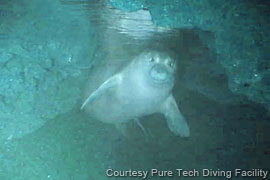 |
|
|
|
Simon Nadim, Managing Director of the Pure Tech Diving Facility in Batroun, Lebanon, contacted TMG to report two separate sightings of a Mediterranean monk seal, on the 15.08.2010 and 04.09.2010 respectively.
The encounters both occurred while diving amongst caves in northern Lebanon and were recorded on video. The animal was reported to be at least 2m in length, and evidently in good physical condition.
Given the extreme rarity of the species, and its sensitivity to human disturbance, the exact location of the sightings was kept confidential.
The Mediterranean monk seal has been considered extinct in Lebanon since at least the 1990s, and it is likely that this particular individual originated elsewhere.
It may or may not be coincidence that seal sightings were also reported along the coast of Israel earlier this year, where the species was also previously considered extinct.
Our thanks to Simon Nadim and Karim Hermes of Pure Tech Diving Facility for sharing this important information and video footage. Pure Tech’s Facebook page.
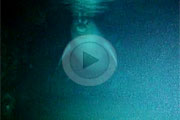 |
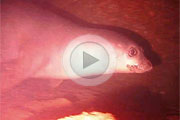 |
|
|
First sighting on 15.08.2010. |
Second sighting on 4.09.2010. |
On 2 June 2010 the seal known as Birisca was found dead in Arco de São Jorge, located in the north of Madeira Island. She was one of the best known seals of the Desertas Islands population, first identified in 1993 when she was already a reproductive female. She was named ‘Birisca’ because of the presence of two (bi) lines (riscas) on the right shoulder. She measured 2.62 meters, weighed 192 kg, and was estimated to be at least 21 years of age.
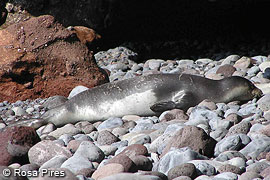 |
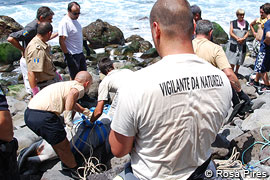 |
|
|
Birisca, bearing the two scars that inspired her name. |
Operation to remove Birisca's body. |
It was with ‘Desertinha’, who died in 2008, that they became the first females to again use open beaches for pupping and nursing in the Desertas Islands [see One pup - three “mothers”, TMG June 2004].
Although Birisca was not reproducing anymore she contributed to the monk seal population increase in Desertas, giving birth at least 8 times.
The body of the seal was detected by a resident on the night of 2 July. The next day, the Parque Natural da Madeira Service, with the collaboration of the Madeira Whale Museum, the Maritime Police and the city council of Santana, removed the body from the isolated stony beach by sea by boat. Currently the body is stored frozen in the Madeira Whale Museum. It is thought that old age contributed to her death, but a necropsy scheduled for January will hopefully determine a more precise cause of death. – Rosa Pires, Parque Natural da Madeira Service.
In June 2010 a new camera surveillance system was installed at Luc Hoffmann’s beach. Using tried and tested equipment, the system will cover the entire beach area (circa 500m). Monitoring of the beach has become necessary due to the increasing numbers of monk seals that occupy it; the birth of a pup was also detected last year. The main purpose of this installation is to monitor the area without causing disturbance to the animals, especially during the breeding season.
The camera was hooked-up to the small encampment located on top of cave 3. In June the installation was completed and checked, ready for the upcoming breeding season.
Unfortunately, the surveillance of another female-pup pair at this open beach will have to wait, at least for another year. Heavy groundswell during these last months, together with poor sea conditions last year, have swept all the sand off the shore, which means that the beach has disappeared this year.
Thus not only has no breeding taken place here, but it has been rare to see animals resting on what was once a large beach.
Sea conditions are showing signs of improvement, which means that the sand will start to accumulate again and the beach return. We hope that by next year the beach will again be occupied by seals. – Mercedes Muñoz and Hamdi M’Bareck, CBD-Habitat.
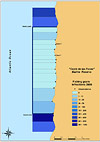 |
|
Since 2009 a new monitoring effort is being developed north and south of the boundaries of the ‘Coast of Seals’ reserve. Twice a week, the conservation wardens extend their surveillance 1,5km north and south to collect information about the fishing pressure over the boundaries of the reserve.
When the infractions committed inside are compared with the fishing pressure outside the reserve, we can determinate if the absence of infractions is due to the effectiveness of the surveillance or the lack of fishing pressure in the area during that period.
The map presented here is a compilation of the data taken from last year (2009). In it, the coast is divided into different sections in which the number of detections is reflected in a colour pattern.
As we can see, most of the fishing effort is concentrated at the external areas closer to the boundaries. This indicates that the fishermen are not only respecting the boundaries of the reserve but that “la costa de las focas” has become an important refuge for the seals to breed without fishing threats. – Abba M’Bareck and Hamdi M’Bareck, CBD-Habitat.
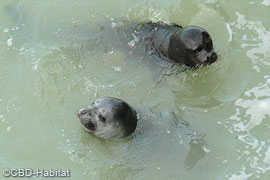 |
|
|
|
Although still missing one month until the end of the pupping season, to date there have been 55 newborn pups at Cabo Blanco. The birth rate improves upon last year’s (51 pups in 2009) and confirms the positive trend when compared with the 24-28 births at the beginning of the last decade.
The peak birth period was October, with 19 newborn pups registered; followed by September with 10.
67% of the births took place in one of the two main breeding caves of the colony. Where neonatal mortality is concerned, it has to be said that 12 dead pups were detected that were less than two months of age, while another 6 disappeared; giving a rate of between 22 and 33%.
The sex-ratio is inclining towards females with 61% of the births versus the 39% for males. The dependability of veteran females and the incorporation of new reproductive ones are ensuring a successful breeding season. We hope that the season’s birth record continues to rise until the end of the year, as a positive sign of the recovery of the Cabo Blanco colony. – Miguel Ángel Cedenilla, Anna Varea and Moulaye Haya, CBD-Habitat.
Mediterranean News continues with Turkey...
The views expressed by outside contributors do not necessarily reflect those of The Monachus Guardian.
|